EXCL: Harvard scientists share UFO retrieval findings
EXCLUSIVE: UFO-hunting Harvard scientists say debris from unidentified object that crashed into Pacific Ocean in 2014 appears ‘artificial in origin’ – and they could be remnants of an ‘interstellar spacecraft’
Tiny metal fragments recovered from an interstellar object that crashed into the Pacific Ocean appear ‘artificial in origin’, scientists say.
A Harvard duo recovered 50 unusual iron spheres after tracking down the unidentified object, known as IM1, off the coast of Papua New Guinea last week as part of a $ 1.5 million underwater search mission.
New lab analysis of the metal spheres reveals they are ‘anomalous’ and stronger than any observed meteor produced by nature, according to Professor Avi Loeb, former chair of Harvard’s astronomy department who led the research.
Professor Loeb – who has been dubbed ‘the alien hunter of Harvard’ – told DailyMail.com: ‘This composition is anomalous compared to human-made alloys, known asteroids and familiar astrophysical sources.’
NASA says IM1 almost certainly came from outer space – making it Earth’s first known interstellar visitor – and crashed into the ocean in 2014, but it was only detected by Professor Loeb and Harvard researcher Amir Siraj in a retrospective analysis.
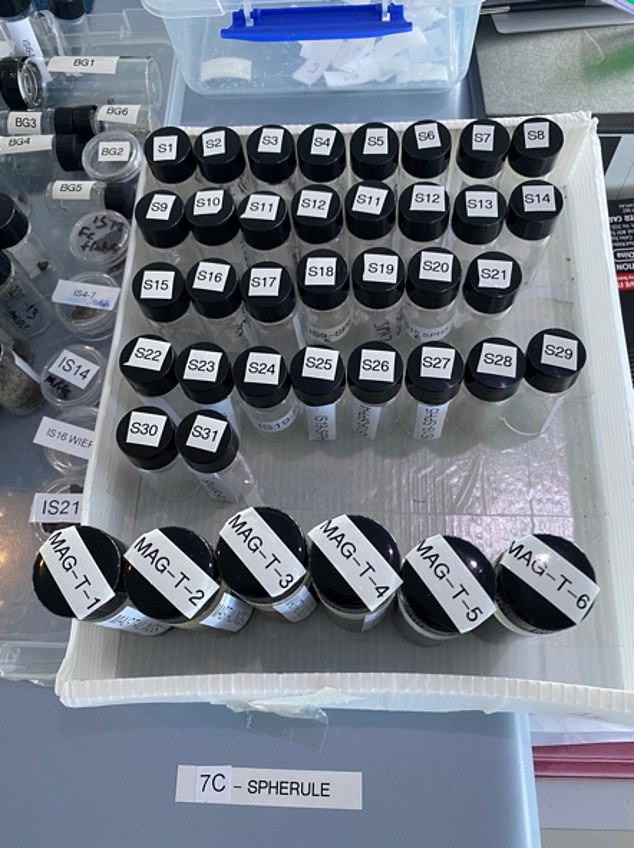
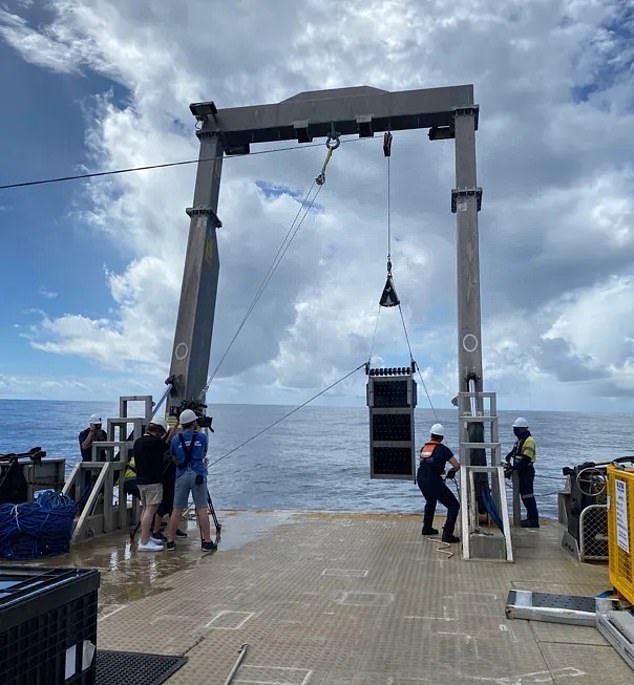
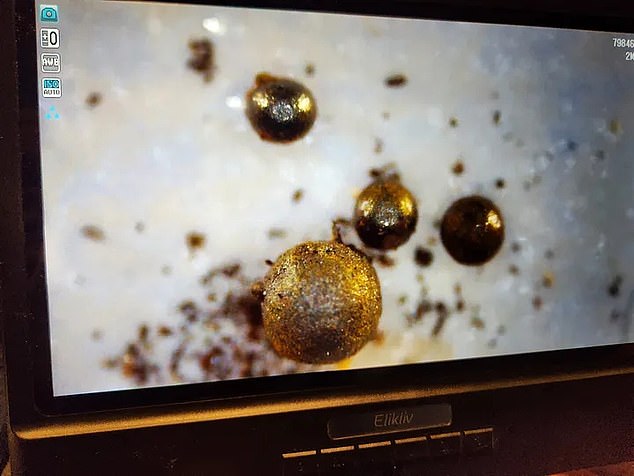
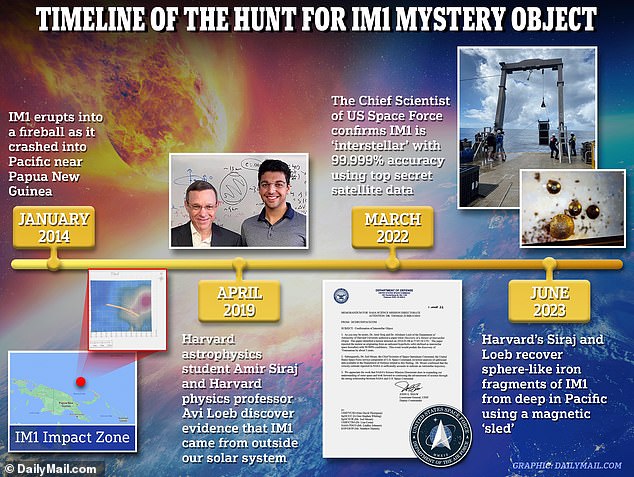
The Harvard pair argue their new results support the likelihood that IM1 was ‘artificial in origin’ – and have refused to rule out that it was part of an ‘interstellar spacecraft’ made by aliens.
Siraj, who first discovered IM1, told DailyMail.com: ‘It’s really important to continue pushing the boundary in terms of destigmatizing the search for extraterrestrial life,’
‘If you don’t consider a possibility, you usually won’t discover something new.’
IM1 withstood four times the pressure that would typically destroy an ordinary iron-metal meteor — as it hurtled through Earth’s atmosphere at 100,215 miles per hour.
Iron is already the principal ingredient in the toughest known kinds of natural meteors, so the Harvard duo has theorized that there must be something highly unusual about how the object came to be made.
And now a battery of tests on the recovered IM1 fragments, conducted at Berkeley, has proven that their chemical make-up is almost entirely iron: strong evidence in favor of the Harvard team’s most controversial theories about the object.
Professor Loeb told this website: ‘More than 95 percent of all meteorites contain iron-nickel metal,’ he added. ‘As a consequence, meteorites have concentrations of nickel that are much greater than that of nearly any terrestrial rock.’
In contrast to these standard iron-nickel meteorites, the IM1 fragments contained only ‘negligible’ amounts of nickel, alongside other ‘trace elements,’ according to a preliminary statement supplied to DailyMail.com over the weekend.
Trace elements, in this kind of scientific analysis, means any chemical compound or atomic element that is present only in vanishingly small quantities, lower than 100-parts-per-million.
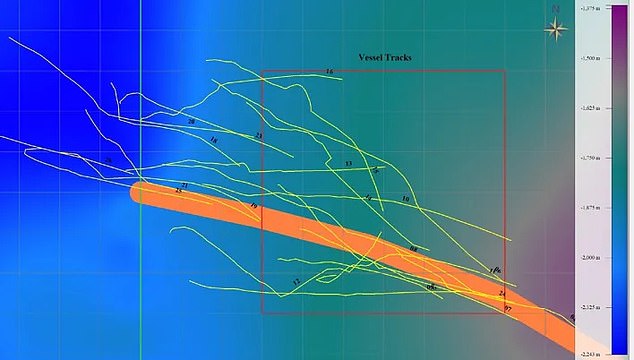
The Harvard team took care to ensure that the 50 spherical iron fragments dredged up from over a mile below the surface of the Pacific were, in fact, actual remnants from IM1.
First, Siraj narrowed down the final trajectory of IM1 as it burst into flames on its way toward the ocean, tracking its airbursts with US Department of Defense satellite data and local seismometers set up to monitor earthquakes and volcanic activity.
With high confidence that the final path for IM1 covered 6.2 square-miles (16 sq-km) of ocean near Manus Island, the team was then able to scrape the deep ocean floor with a large magnetic ‘sled’ — both along IM1’s path and several ‘control’ regions.
The control regions served as a control to make sure more iron spheres spheres had not found their way onto the ocean floor via some event unrelated to IM1’s fall to Earth.
‘The spherules were mostly found along the expected meteor path,’ the Galileo team said in the preliminary statement.
The unusual iron composition of the spheres, they report, ‘indicate a common source’ which they argue is ‘different from background spherules found in control regions.’
Siraj — who told DailyMail.com that he traveled 50 hours across four connecting flights to join the expedition from his sister’s wedding in the English countryside — said the chances of successfully locating IM1’s remains had been quite low.
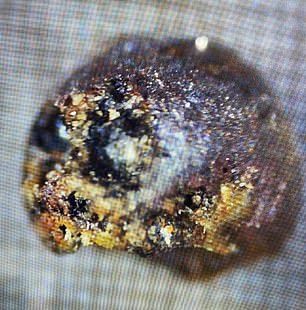
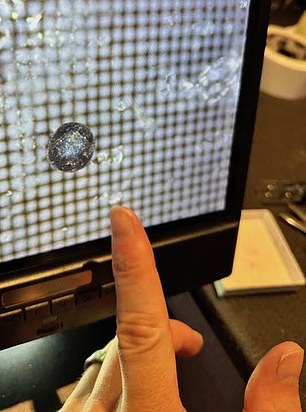
‘Looking for a needle in a haystack is way easier than what we were trying to do,’ Siraj said via phone.
‘It’s the world’s most unforgiving haystack.’
Two factors, however, did play to their advantage, Siraj noted.
First, the ocean depth of the impact zone, about 20 miles north of Manus Island off the coast of Papau New Guinea, raised the likelihood that settled fragments of IM1 could have remained ‘unperturbed for a decade’ ever since IM1’s splashdown on January 8, 2014.
Second, as IM1 burst into flames above the Pacific, the unique properties of molten iron the metal rained down through Earth’s atmosphere was scientifically known to form droplets about 10-700 microns thick, as small as, or smaller, than grains of table salt.
Professor Loeb has courted controversy, as well as millions in independent financing, over his quest to identify outer space materials like this — material that could serve as physical evidence or artifacts of an alien civilization probing our solar system.
Last year, in March of 2022, scientists and classified tech with US Space Command confirmed Professor Loeb and Siraj’s 2019 calculations on IM1’s interstellar trajectory, reporting in an official letter to NASA that they were 99.999 percent sure the object came from outside our solar system.
The Galileo Project’s critics in the world of astronomy and astrophysics had expressed skepticism over the notions that IM1 might be interstellar or composed of entirely iron metal, but on both of these details, their skeptics have been proven wrong.
Professor Loeb and his team have learned that iron is the ‘dominant constituent’ of the IM1 spheres’ chemical make-up thanks, first, to some initial on-ship analysis and, now, the new, more thorough analysis conducted at the University of California, Berkeley.
The findings are a solid rebuke to astrophysicists with Canada’s Institute for Earth and Space Exploration, who argued that their computer modeling of IM1’s behavior before impact ‘strongly argues against an iron object.’
Siraj expressed confusion at the Canadian institute’s approach to their IM1 analysis.
‘Instead of concluding that their model might be incomplete,’ Siraj told DailyMail.com, ‘because it’s trained on meteors with much, much lower material strengths, they concluded that the data must be wrong.’
‘The logic is a little bit confounding,’ he said.
Currently, IM1 is ranked first in terms of material strength out of all 273 fireballs in NASA’s Center for Near-Earth Object Studies (CNEOS) meteor catalog.
Siraj expressed hope that further work on IM1 will help destigmatize research in new fields of science, not just the search for extraterrestrial life.
‘Interstellar objects themselves shouldn’t be controversial,’ Siraj said, ‘but they’re sometimes perceived as controversial because it’s a new field.’
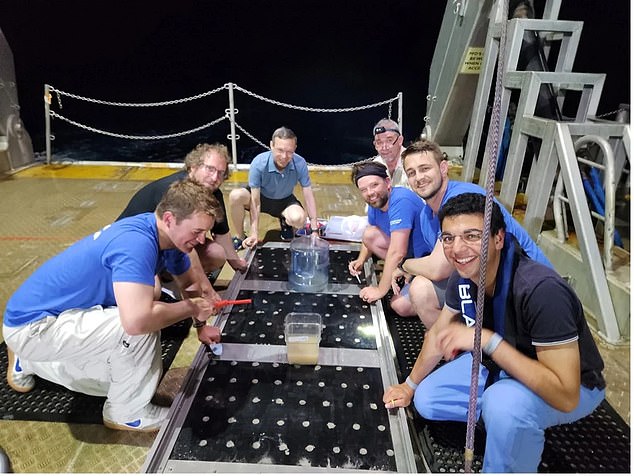
The new analysis at Berkeley came via the assistance of nuclear scientist Ryan Weed, an active duty US Air Force test pilot whose physics research involves novel propulsion systems.
Galileo’s IM1 samples were tested via inductively coupled plasma mass spectrometry (ICP-MS) to better determine whether or not its ratio of iron isotopes matched what’s typically found in our solar system — or if the isotopes were themselves ‘anomalous.’
The Berkeley tests also included an analysis of the microscopic shape details, or ‘morphology,’ of the spheres using a scanning electron microscope; as well as a deeper investigation into the sphere’s chemical make-up via energy-dispersive x-ray spectroscopy.
Although more work remains to be done with the data collected from all this equipment, the Galileo team reports that the results, so far, ‘hint at the interstellar origin suggested by the measured IM1 velocity,’ as first calculated by Siraj in 2019 and proven by US Space Force in 2022.
Although the behavior and fragments of IM1 do not resemble the vast majority of known meteors and asteroids, Professor Loeb and Siraj noted that they must consider at least one possible means by which IM1 could have been naturally made by the cosmos.
Distant supernovae, exploding stars at the end of their existence, have been theorized to launch iron-rich ‘bullets,’ as suggested by past radio and x-ray observations by astronomers, including Professor Loeb in the early 1990s.
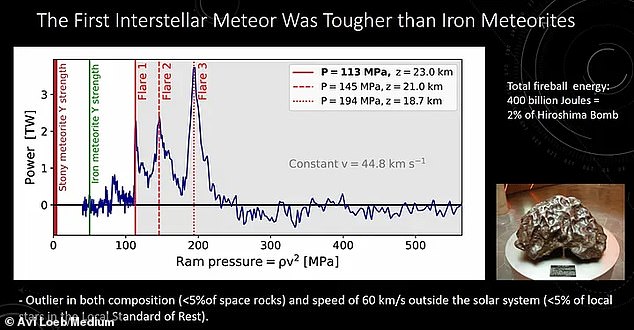
IM1 could still prove to be a highly unusual, but natural iron bullet launched from an exploding star.
‘The fundamental question is whether the meteor was natural or technological in origin,’ according to Professor Loeb. ‘We hope to answer this question by further analysis of its isotopic composition and radioactive dating.’
But IM1 was not the only object that Siraj and Professor Loeb discovered that showed an interstellar trajectory.
Professor Loeb said that either IM1 or the second object, IM2, the third strongest meteor in NASA’s CNEOS fireball catalogue, may ‘move fast and are tough because they are artificial in origin, namely chemically-propelled interstellar spacecraft.’
The objects, Professor Loeb said, could be ‘like our own interstellar probes, but launched a billion years ago.’
Siraj told DailyMail.com that he is even more optimistic about the potential success with their second hunt for physical evidence from an interstellar object.
IM2, he said, was much larger than IM1, at eight-times the mass, and it was traveling much more slowly through Earth’s atmosphere when in splashed into the Atlantic Ocean off the coast of Portugal.
‘There’s a higher chance of finding larger fragments from that one,’ Siraj said, because less of IM2 had a chance to melt away at its size and speed.
The Galileo Project will ‘hopefully’ be dredging up samples from this second interstellar object, he said, ‘within the next couple of years.’
This article has been archived for your research. The original version from Daily Mail can be found here.


